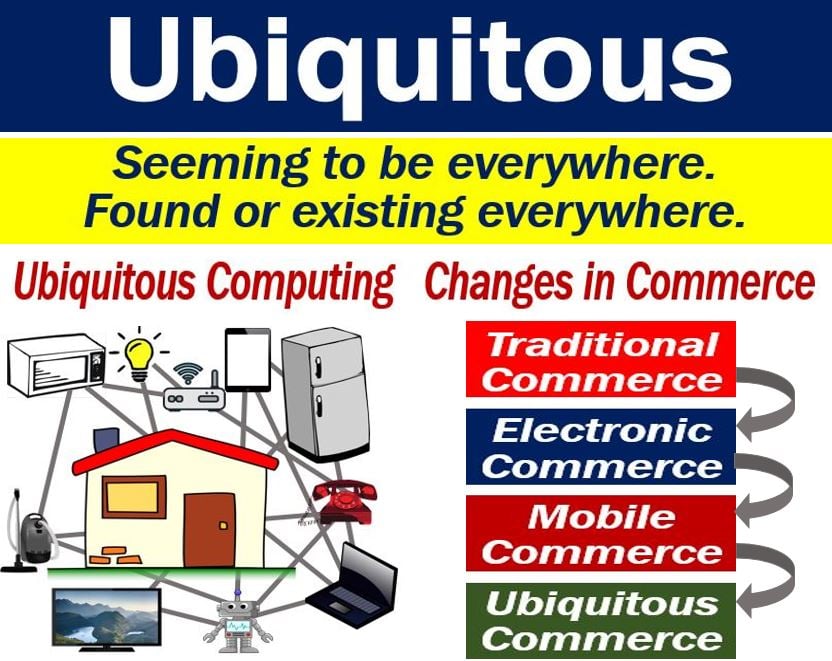What is ubiquitous? Definition and examples
If something is ubiquitous, it means that it seems to be everywhere. The term may also mean that something seems to have the ability to be everywhere at the same time, i.e., omnipresent. For example, if I say “Everybody felt the leader’s ubiquitous influence,” it means that the leader’s influence was everywhere.
We also use the term to say that something is extremely popular. For example “Nobody wore jeans 200 years ago, but today they are ubiquitous.”
The Oxford Learner’s Dictionary has the following definition of the term:
“Seeming to be everywhere or in several places at the same time; very common.”
Etymology of ‘ubiquitous’
Etymology is the study of the origin of words and how their meanings have evolved. It also looks at how the structures of words have changed. An etymology expert is an etymologist.
The term first appeared in the English language with its modern spelling in 1800. It meant ‘existing or turning up everywhere.’
There was another word – Ubiquitary – which had existed since 1600. It came from the Modern Latin word Ubiquitarius, which came from Ubique. Ubique meant ‘everywhere.’

In business
If something is ubiquitous in the world of business, it means that many organizations and people have adopted it. It also means that you can find it everywhere. Put simply; it means that it is ‘widespread.’
Many best practices are widespread, as are different types of technology.
According to the Corporate Finance Institute, the following technologies are ubiquitous in business:
- Email.
- MS Excel.
- MS PowerPoint.
- Data management systems.
- Skype.
- VoIP (Voice over Internet Protocol).
Many business practices are also ubiquitous, such as performance reviews, risk management strategies, and SWOT analysis.
SWOT analysis is a technique that helps organizations and individuals identify key strengths, weaknesses, opportunities, and threats. SWOT stands for Strengths, Weaknesses, Opportunities, and Threats.
Ubiquitous commerce
The term ubiquitous commerce or U-commerce describes all business transactions that occur online or via communications technology.
Do not confuse the term with TouchNet’s U.Commerce. TouchNet Information Systems has a set of products and services it calls U.Commerce.
According to Richard T. Watson, J. Rex Fuqua Distinguished Chair of Internet Study at the University of Georgia, ubiquitous commerce has four main features:
1. Ubiquitous
This represents the ability to connect whenever and wherever you are. It also represents the integration of human-computer interaction into most processes and devices.
By devices, he includes office and household ones. He also includes those in the streets, our gardens, parks, airports, hospitals, etc.,i.e., everywhere.
2. Uniqueness
Uniqueness stands for the unique identification of each consumer, customer or user. It refers to the customer’s current context, identity, needs, and location resulting in an individual service.
3. Universal
Apart from having a connection regardless of where we are, universal also means being able to use all of our devices multifunctionally.
4. Unison
Unison relates to having fully synchronized devices whenever we need them. It also constitutes data integration across different devices and applications.
Ubiquitous computing
Ubiquitous computing is a software and computer science concept in which computing appears everywhere and anytime. We also call it ‘ubicomp.’
Unlike desktop computing, ubicomp can occur using any device in any format. It can also occur anywhere.
The user can interact with a laptop, tablet, smartphone, or any computer or device. Even refrigerators, microwave ovens, and glasses, for example, are hooked up to the system.
Wikipedia says the following regarding the underlying technologies that support ubicomp:
” The underlying technologies to support ubiquitous computing include Internet, advanced middleware, operating system, mobile code, sensors, microprocessors, new I/O and user interfaces, networks, mobile protocols, location and positioning, and new materials.”

